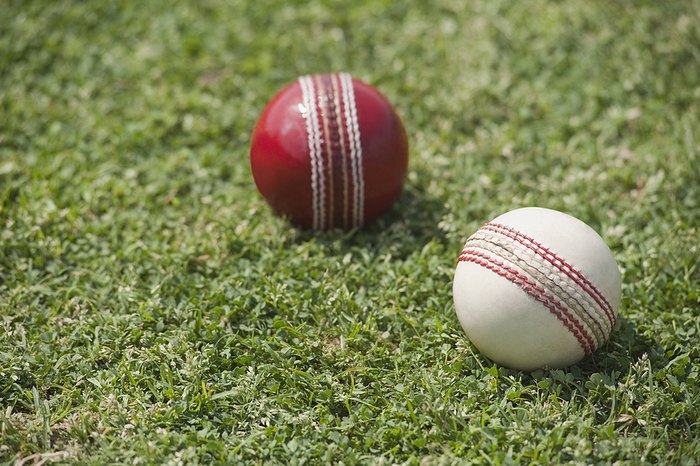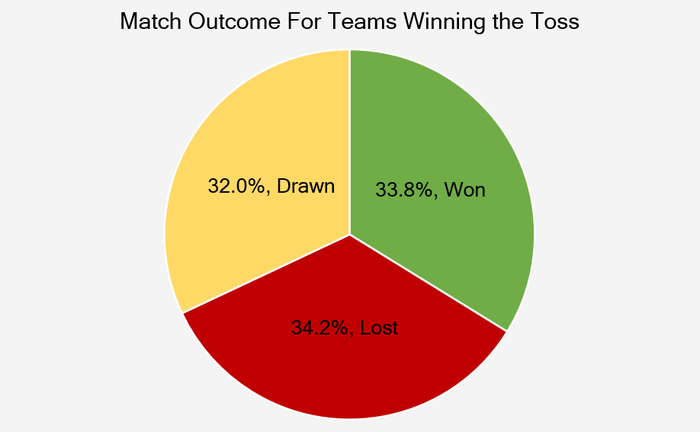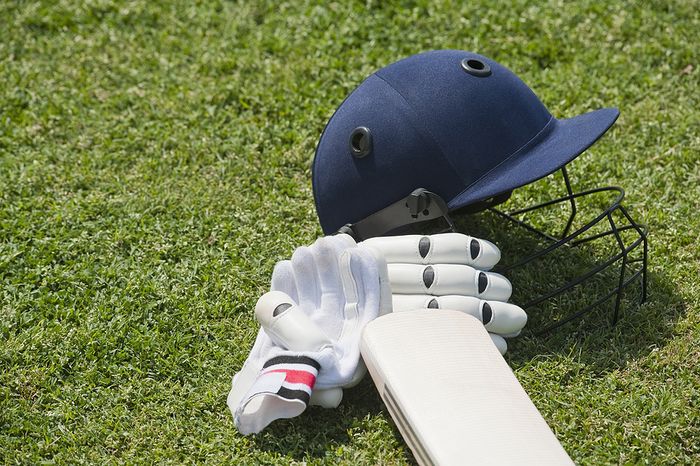 There are several sports that use the toss of a coin to decide how a game starts. In tennis, for instance, it is often used to decide who serves first, in football to determine who kicks off and in snooker to ascertain who will break first. Whilst in these sports the advantage of winning the toss varies between virtually nothing (football) and relatively little (tennis), in cricket, the coin toss has long been deemed a key moment of any given match.
There are several sports that use the toss of a coin to decide how a game starts. In tennis, for instance, it is often used to decide who serves first, in football to determine who kicks off and in snooker to ascertain who will break first. Whilst in these sports the advantage of winning the toss varies between virtually nothing (football) and relatively little (tennis), in cricket, the coin toss has long been deemed a key moment of any given match.
The received wisdom is that the coin toss can virtually decide the result of the game, certainly in some situations, where the wicket is set to deteriorate for example, or conditions are forecast to improve after a very cloudy first morning. But is received wisdom correct? Does it really matter who wins the coin toss in cricket?
Why Does The Toss Matter?

The captain that wins the toss gets to decide whether their team will bat or bowl first and this can have a big influence on the game. The way the decision to bat or bowl affects the match varies a little between the formats, with subtly different factors being important depending on whether we are talking about T20, a 50-over game, or a Test (or any of the other formats of the game).
Limited Overs Cricket (White Ball)
In white ball cricket one of the most important factors is whether a side feels happier chasing a score or setting a target for the other team to chase. Generally speaking, batting second is considered to be the better option as the chasing side knows exactly what is required of them and does not need to gauge their innings based on an assessment of what might be a good score. That said, often the decision depends on the make-up of the side and whether the skipper has more confidence in their batting unit or their bowling unit.
Of course, conditions play a big part in things too, even in short-form cricket. Dew on the outfield can be a factor in day/night games, as can the way the ball reacts under the lights and thus how easy it is for batsmen to pick it up, as well as other factors such as the weather and atmospheric conditions.
Test Matches (Red Ball)
In Tests and other red ball cricket matches the deterioration of the wicket is often the biggest factor that affects whether a captain will choose to bat or field first. The wicket is usually at its best earlier in the game and almost always at its worst at the end. Batting last can be almost impossible, especially in India, Pakistan and Bangladesh, where spinner-friendly surfaces make chasing a total a treacherous challenge.
However, often there may be a little more in the wicket for bowlers on the first morning, especially if the forecast is for a cloudy start. Should a captain win the toss they must weigh up the various factors that might be relevant and decide whether they think batting or bowling first is most likely to yield a positive outcome.
What Does the Data Tell Us?
![]() Whilst the impact of the toss has changed over the years, what is the general picture? Does winning the toss mean the chances of winning the game are greatly increased? When all’s said and done, how important is the toss?
Whilst the impact of the toss has changed over the years, what is the general picture? Does winning the toss mean the chances of winning the game are greatly increased? When all’s said and done, how important is the toss?
The simplest way to assess whether the coin toss matters is to look at results. Does the team that wins the toss win more often? Cricket is a sport that is full of stats and there is a wealth of information on this subject, with entire books dedicated to it and no doubt scientific research papers too. The importance of the toss has changed over time and varies depending on the format of the game.
The excellent 2020 book Hitting Against the Spin: How Cricket Really Works, written by Ben Jones and Nathan Leamon uses data to unpick a lot of cricket myths and analyse many of cricket’s unwritten laws. Among the things it looks at is the importance of the coin toss, rather helpfully for us!
How Often Do Teams Winning the Toss Win the Game?
Jones and Leamon’s book focuses on Tests and noted that in the 1,000 such matches up to around 2010, the side that won the toss was victorious 338 times and the side that lost the toss actually won the match 342 times. Oh dear, so much for that received wisdom. From a purely mathematical basis, history showed that losing the toss made a side more likely to win the match. It isn’t statistically significant that the toss-loser won four more games out of 1,000, but it does at the very least cast major doubts over the idea that winning the toss is crucial to the outcome of the game.

They then looked more closely at the past 40 years of the five-day game and uncovered that there was no period within that time when calling correctly at the toss made any real difference to results. However, further analysis showed that in terms of the toss we can separate Test cricket into three different eras. From 1980 to 2010 the stats showed that winning the toss was, essentially, unimportant as a predictor of the result. This seems strange and the reasons behind it are fairly complex and beyond the scope of this article. Check out the book, especially if you love cricket, statistical analysis or both.
Prior to that period, batting first had been very advantageous, primarily due to how the weather affected the uncovered pitches. As such, 89% of captains that won the toss, opted to bat, and their positive results meant that winning the toss did indeed confer a real advantage.
That batting first had been successful for so long meant that when covered pitches came in and the equation changed, captains were slow to realise that it was no longer necessarily to their advantage. Between 1980 and 2010 around two-thirds of captains who won the toss continued to bat first but in this period the side bowling first actually won more games (36% versus 31%). As such, winning the toss statistically harmed a team because, quite simply, on average the captains made the wrong decision and opted to bat when they should have bowled.
Batting First Is More Important

According to the authors of the book from where much of this information is drawn, we are entering a new modern era with regards to the power dynamic between batting and bowling first and the coin toss. It may be too early to definitively state this is the case but since the beginning of 2014, the team batting first has won a whopping 56% of Tests, losing just 29%. That was based on a sample size at the time of the research of 280 matches, a not insignificant number.
With the side batting first holding such a strong advantage, clearly winning the toss too becomes highly beneficial (as the captain can elect to bat first). Separating cause from effect is not easy and there are so many possible explanations and variables involved. Once again, it is beyond the scope of this feature to explain why this shift has occurred but pitches being better to begin with but deteriorating more quickly is a factor. The increased role of spinners, partly because of the advent of DRS, is another, as is the rapidly decreasing frequency of drawn games.
No matter what the explanation though, the authors of Hitting Against The Spin fear for the game if this statistical trend continues or increases. As they note “A sport where a coin toss makes one side twice as likely to win would lose a lot of its appeal”.
Overall Test Stats

By Shehanw, Wikimedia Commons
Based on stats drawn from the cricket stats site HowSTAT, we can see that over the entire history of Test cricket, winning the toss has helped sides to win. The impact of winning the toss is very slightly higher on home territory, improving a side’s chances by 13.1% as compared to 11.5% away from home. Note that the stats below are correct as of July 2021 and exclude 54 games that were played at neutral venues.
| Toss Result | Matches | Won | Drawn | Lost | Win % |
|---|---|---|---|---|---|
| Home side won | 1247 | 549 | 387 | 311 | 44.03 |
| Home side lost | 1125 | 438 | 374 | 313 | 38.93 |
| Away side won | 1125 | 313 | 374 | 438 | 27.82 |
| Away side lost | 1247 | 311 | 387 | 549 | 24.94 |
The 13.1% and 11.5% figures quoted above are the increase in games won expressed as a percentage of those won when the toss is lost. The actual increase in games won overall is smaller, just 2.88% of the total games when on tour and 5.10% when the host nation. So whilst winning the toss has undeniably helped, historically speaking it has not been a huge factor.
Overall Limited Overs Stats

By Paramgoel, Wikimedia Commons
White ball cricket is less affected by conditions, both in terms of the wicket and the weather; and so, with fewer variables, it might be easier to assess the value of winning the toss. In addition, it has a far shorter history, especially in the case of 20 over games (T20s). Strategy in both 50 and 20 over games have changed over the years and also differ depending on the tournament in question.
Traditionally, chasing has always been favoured as it is deemed better to have a clearly defined target. That said, in a sense, the team bowling second effectively also has a clear target and knows whether they must attack and look to take wickets or can defend and hope to keep things tight.
In truth, we have struggled to uncover any rock-solid stats or research for ODIs or T20 clashes, with lots of information either out of date, tournament-specific, incomplete or unreliable. According to one source, for all One Day Internationals played up until 2006, teams that won the toss went on to win the game 49.1% of the time, compared to 47.3% for the losing side.
Based again on information from HowSTAT we can see that England were markedly more successful batting second than they were when bowling second. India too prospered when batting second but confounding these stats are Australia’s results. Again note that this table is correct as of July 2021, and that matches at neutral venues have been classed as being away.
| England Win % | India Win % | Australia Win % | |
|---|---|---|---|
| Batting 1st at Home | 52.71% | 56.49% | 69.75% |
| Batting 2nd at Home | 66.46% | 64.25% | 61.90% |
| Batting 1st at Away | 42.92% | 48.08% | 59.34% |
| Batting 2nd Away | 53.30% | 54.49% | 63.21% |
In addition to Australia’s mixed stats, Pakistan also won fewer games batting second, in their case away from home, a picture echoed by South Africa and Sri Lanka, whilst the West Indies aligned with England and India in winning more games home and away when chasing a target.
The fact that we are talking here not about who wins the toss but simply how performances vary according to batting first or second means we can read even less into these stats. However, if we saw a very clear picture that batting first, or batting second, consistently led to better results, it would be safe to assume that winning the toss should also confer a considerable advantage.
That said, as we have seen with Test results at different times, there is no guarantee that the skipper who wins the toss will make the “right” decision. As well as being slow to react to changes in trends, captains may misread the situation in a specific match, so coupled with the fact that we see mixed stats with regards batting first or second anyway, and the overall stats up to 2006, it seems that winning the toss is of limited value at best in One Day Internationals (ODIs).
The IPL Toss

By Paramgoel, Wikimedia Commons
T20 has an even shorter history than 50 over cricket but with so many matches and leagues around the world there is still plenty of information to go on. Once again though, we have little in the way of comprehensive, reliable analysis to go on, so let us instead focus more on the IPL in recent seasons. In an Indian Express article titled “How T20 in sub-continent has become win-toss-win-game format”, Vishal Menon noted that “Win the toss, bowl first and win the match seems to be the mantra for success in the subcontinent.”
He noted that during the 2019 IPL more than 61% of matches were won by teams bowling first and that during the most recent edition of the Pakistan Super League “13 out of the 14 games were won by teams that won the toss and decided to chase”. There is further analysis of T20 internationals between the 10 Test-playing nations that covers the first 11 years of the sport. Published in 2016, it is by now somewhat dated but it showed that from 2012 to 2016 the team batting first won 88 times and lost 64 times.
Moreover, this research suggested that the record of teams batting first was improving, with the win/loss ratio coming in at 62:59 for games from the start of 2008 to the end of 2011. Ultimately it may be the case that the relative newness of the T20 format means that we cannot draw any firm conclusions about how important the toss is.
Though the first T20 international was played as long ago as 2004, nations are still developing strategies and players are still learning how to handle the unique pressures of such a short format. The fact that these 20 over games are more easily swung by one or two brilliant performances also makes them more unpredictable and as such muddies the statistical waters. Overall, therefore, we would suggest that the coin toss may be of the least importance when it comes to this format, but as with all forms, it could be an evolving picture.
Should the Toss Be Scrapped?

At times when the toss has appeared to give too much of an advantage to whichever side wins it, the cricketing authorities have taken measures to try and reduce this. There has been talk of getting rid of the toss entirely, or only using it for the first game of a series and then alternating which side gets to choose who bats.
In the international game and to a lesser extent even in club cricket, the issue of the coin toss is often linked to the benefit of home advantage. In the 21st century winning Tests away from home has been difficult, with the International Cricket Council (ICC) concerned about home sides preparing wickets that confer too much advantage to the home side.
To offset this the ICC considered scrapping the toss and instead simply letting the away side choose whether to bat or field. A similar rule was introduced in English county cricket where the away captain can automatically choose to bowl first if they want, a change designed to lead to better wickets.
Betting On The Coin Toss

One of the worst markets you can bet on when it comes to any sport is the coin toss in cricket. No matter what any tipping sites say and no matter how many previous tosses a captain has won or lost, this remains a bet where we absolutely know that each side has a 50% chance of winning.
This means that odds over evens (2.0 in decimal odds) are a value bet and you will never, ever see either side priced at odds even close to evens. At the very, very best, you might get 19/20, with 10/11 or 5/6 far more common. A market where you can categorically never uncover value is one to be avoided but that is not to say the toss is irrelevant when it comes to betting.
 As we have seen when it comes to Tests and to a lesser degree in the white ball game, winning the toss has a serious impact on the outcome of a game. Unsurprisingly, therefore, it also has, at times, a big effect on the odds. Knowing how important the toss will be in a given game may help you better assess the value on both sides.
As we have seen when it comes to Tests and to a lesser degree in the white ball game, winning the toss has a serious impact on the outcome of a game. Unsurprisingly, therefore, it also has, at times, a big effect on the odds. Knowing how important the toss will be in a given game may help you better assess the value on both sides.
For example, if we consider a hypothetical game between Australia and India in Mumbai that is taking place on a typical Indian wicket, depending on the odds, there may be value in backing the away team. Of course, the odds will often take account of the uncertainty of the toss but this is not always the case, or at least sites may underestimate the impact of the toss.
If you predict that the side batting first will have a major advantage, yet note that the odds are very much in favour of one side (in this instance typically India), the underdog may be value. Australia have a 50% chance of winning the toss and if they do, they may well stand a very real chance of winning the game, despite being priced at, for example, odds of 6/1 prior to the toss.
The toss will also have an impact upon other markets, and the quick and canny punter may be able to take advantage of prices that are slow to react to it. In addition, you may also see other specials markets offered by bookies that include or relate to the coin toss. One such example is “To win the toss and win the match”.
